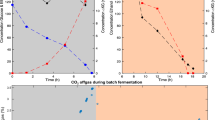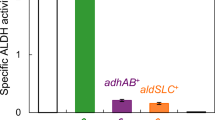Abstract
Glucose catabolism by the obligatory aerobic acetic acid bacterium Gluconobacter oxydans 621H proceeds in two phases comprising rapid periplasmic oxidation of glucose to gluconate (phase I) and oxidation of gluconate to 2-ketogluconate or 5-ketogluconate (phase II). Only a small amount of glucose and part of the gluconate is taken up into the cells. To determine the roles of the pentose phosphate pathway (PPP) and the Entner–Doudoroff pathway (EDP) for intracellular glucose and gluconate catabolism, mutants defective in either the PPP (Δgnd, Δgnd zwf*) or the EDP (Δedd–eda) were characterized under defined conditions of pH 6 and 15 % dissolved oxygen. In the presence of yeast extract, neither of the two pathways was essential for growth with glucose. However, the PPP mutants showed a reduced growth rate in phase I and completely lacked growth in phase II. In contrast, the EDP mutant showed the same growth behavior as the reference strain. These results demonstrate that the PPP is of major importance for cytoplasmic glucose and gluconate catabolism, whereas the EDP is dispensable. Reasons for this difference are discussed.





Similar content being viewed by others
References
Ano Y, Shinagawa E, Adachi O, Toyama H, Yakushi T, Matsushita K (2011) Selective, high conversion of d-glucose to 5-keto-d-gluconate by Gluconobacter suboxydans. Biosci Biotechnol Biochem 75:586–589
Bradford MM (1976) A rapid and sensitive method for the quantitation of microgram quantities of protein utilizing the principle of protein-dye binding. Anal Biochem 72:248–254
Kersters K, Lisdiyanti P, Komagata K, Swings J (2006) The family Acetobacteriaceae: the genera Acetobacter, Acidomonas, Asaia, Gluconacetobacter, Gluconobacter and Kozakia. In: Dworkin M, Falkow S, Rosenberg E, Schleifer K-H, Stackebrandt E (eds) The prokaryotes, vol. 5, 3rd edn. Springer, Heidelberg, pp 163–200
Krajewski V, Simić P, Mouncey NJ, Bringer S, Sahm H, Bott M (2010) Metabolic engineering of Gluconobacter oxydans for improved growth rate and growth yield on glucose by elimination of gluconate formation. Appl Environ Microbiol 76:4369–4376
Kruger NJ, Von Schaewen A (2003) The oxidative pentose phosphate pathway: structure and organisation. Curr Opin Plant Biol 6:236–246
Matsushita K, Fujii Y, Ano Y, Toyama H, Shinjoh M, Tomiyama N, Miyazaki T, Sugisawa T, Hoshino T, Adachi O (2003) 5-keto-d-gluconate production is catalyzed by a quinoprotein glycerol dehydrogenase, major polyol dehydrogenase, in Gluconobacter species. Appl Environ Microbiol 69:1959–1966
Miyazaki T, Tomiyama N, Shinjoh M, Hoshino T (2002) Molecular cloning and functional expression of d-sorbitol dehydrogenase from Gluconobacter suboxydans IF03255, which requires pyrroloquinoline quinone and hydrophobic protein SldB for activity development in E. coli. Biosci Biotechnol Biochem 66:262–270
Moritz B, Striegel K, De Graaf AA, Sahm H (2000) Kinetic properties of the glucose-6-phosphate and 6-phosphogluconate dehydrogenases from Corynebacterium glutamicum and their application for predicting pentose phosphate pathway flux in vivo. Eur J Biochem 267:3442–3452
Peters B, Junker A, Brauer K, Mühlthaler B, Kostner D, Mientus M, Liebl W, Ehrenreich A (2012) Deletion of pyruvate decarboxylase by a new method for efficient markerless gene deletions in Gluconobacter oxydans. Appl Microbiol Biotechnol. doi:10.1007/s00253-00012-04354-z
Prust C, Hoffmeister M, Liesegang H, Wiezer A, Fricke WF, Ehrenreich A, Gottschalk G, Deppenmeier U (2005) Complete genome sequence of the acetic acid bacterium Gluconobacter oxydans. Nat Biotechnol 23:195–200
Raspor PP, Goranovič D (2008) Biotechnological applications of acetic acid bacteria. Crit Rev Biotechnol 28:101–124
Richhardt J, Bringer S, Bott M (2012) Mutational analysis of the pentose phosphate and Entner–Doudoroff pathways in Gluconobacter oxydans reveals improved growth of a Δedd Δeda mutant on mannitol. Appl Environ Microbiol 78:6975–6986
Schweiger P, Volland S, Deppenmeier U (2007) Overproduction and characterization of two distinct aldehyde-oxidizing enzymes from Gluconobacter oxydans 621H. J Mol Microbiol Biotechnol 13:147–155
Shinagawa E, Ameyama M (1982) 2-Keto-d-gluconate dehydrogenase from Gluconobacter melanogenus, membrane-bound. Meth Enzymol 89:194–198
Weenk G, Olijve W, Harder W (1984) Ketogluconate formation by Gluconobacter species. Appl Microbiol Biotechnol 20:400–405
Acknowledgments
We are most grateful to Armin Ehrenreich and Wolfgang Liebl (TU München) for providing the strain and protocol used for generating the G. oxydans deletion mutants. We also thank DSM Nutritional Products (Kaiseraugst, Switzerland) for the financial support and Dietmar Laudert, Günter Pappenberger, and Hans-Peter Hohmann (DSM Nutritional Products) for their scientific input and their continued disposition for discussion. This work was funded by the German Ministry of Education and Research (BMBF) within the GenoMik-Transfer program (grant 0315632D).
Author information
Authors and Affiliations
Corresponding authors
Electronic supplementary material
Below is the link to the electronic supplementary material.
ESM 1
(DOCX 104 kb)
Rights and permissions
About this article
Cite this article
Richhardt, J., Bringer, S. & Bott, M. Role of the pentose phosphate pathway and the Entner–Doudoroff pathway in glucose metabolism of Gluconobacter oxydans 621H. Appl Microbiol Biotechnol 97, 4315–4323 (2013). https://doi.org/10.1007/s00253-013-4707-2
Received:
Revised:
Accepted:
Published:
Issue Date:
DOI: https://doi.org/10.1007/s00253-013-4707-2




